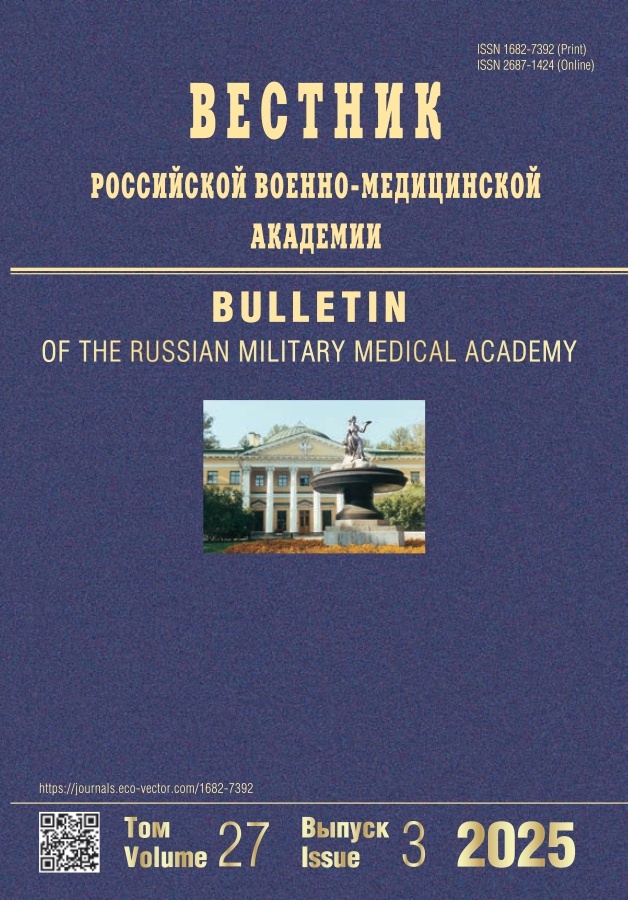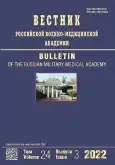Justification of tactical and technical sample requirements mass immunoprophylaxis dangerous infectious diseases in the Armed Forces of the Russian Federation
- Authors: Misnokov O.P.1, Savelyev A.P.1, Stepanov A.1, Bychkov A.P.1, Kuzin A.A.2, Zobov A.E.2
-
Affiliations:
- State Research and Testing Institute of Military Medicine
- Military Medical Academy of S.M. Kirov
- Issue: Vol 24, No 3 (2022)
- Pages: 467-474
- Section: Original Study Article
- URL: https://journals.rcsi.science/1682-7392/article/view/106287
- DOI: https://doi.org/10.17816/brmma106287
- ID: 106287
Cite item
Abstract
The results of the analysis of the current state of creating a technical means of mass immunoprophylaxis for dangerous infectious diseases are presented, including the technical level and trends in the development of developments on this problem in the Russian Federation and abroad. It was noted that in emergency situations of a biological nature, a vaccination campaign should be carried out in a short time with maximum personnel vaccination coverage, which is a massive undertaking. These requirements can be only be met with the use of mass vaccination in the form of needle-free, inhalation (aerosol) and oral vaccine administration methods. The wide use of these methods is constrained by a meager range of domestic oral vaccines, as well as the lack of technical means of mass immunization (aerosol generators, needleless injectors). This article shows that the needleless injector NI-30 (Russia) is the most appropriate for mass vaccination, in terms of technical level and operational characteristics. However, it cannot be recognized as fully meeting modern requirements due to a number of negative aspects, such as the rather large overall injector dimensions creating a large amount of obsolete structural materials. Thus, it is necessary to take into account the features of the available methods of vaccine administration when assessing the prospects for mass immunization, and it is necessary to substantiate the tactical and technical requirements for new generation samples in order to develop the technical means of mass immunization. Therefore, the development and introduction into practice of high-performance methods of mass immunization and the technical means for their implementation continues to be an urgent task.
Full Text
##article.viewOnOriginalSite##About the authors
Oleg P. Misnokov
State Research and Testing Institute of Military Medicine
Author for correspondence.
Email: opmisnikov@mail.ru
SPIN-code: 6382-9462
Doctor of Biological Sciences, ProfessorRussian Federation, Saint Petersburg
Alexander P. Savelyev
State Research and Testing Institute of Military Medicine
Email: bychkoff84@rambler.ru
SPIN-code: 2651-7480
Doctor of Medical Sciences, Professor Russian Federation, Saint Petersburg
Alexander Stepanov
State Research and Testing Institute of Military Medicine
Email: bychkoff84@rambler.ru
ORCID iD: 0000-0002-1917-2895
SPIN-code: 7279-7055
Doctor of Medical Sciences Russian Federation, Saint Petersburg
Andrey P. Bychkov
State Research and Testing Institute of Military Medicine
Email: bychkoff84@rambler.ru
SPIN-code: 5429-8754
Russian Federation, Saint Petersburg
Aleksandr A. Kuzin
Military Medical Academy of S.M. Kirov
Email: paster-spb@mail.ru
ORCID iD: 0000-0001-9154-7017
SPIN-code: 6220-1218
Doctor of Medical Sciences, Associate ProfessorRussian Federation, Saint Petersburg
Andrey E. Zobov
Military Medical Academy of S.M. Kirov
Email: dr.andrey98@yandex.ru
ORCID iD: 0000-0001-7791-8993
SPIN-code: 4281-2680
Candidate of Medical SciencesReferences
- Kryukov EV, Trishkin DV, Ivanov AM, et al. Comparative cohort epidemiological study of collective immunity against new coronavirus infection among different groups of military personnel. Annals of the Russian Academy of Medical Sciences. 2021;76(6):661–668. (In Russ.). doi: 10.15690/vramn1583
- Zobov AE, Karpushchenko VG, Kobylkin DV, et al. Comparative analysis of modern pandemic. Russian Military Medical Academy Reports. 2021;40(S2):99–101. (In Russ.).
- Ivchenko EV, Stepanov AV, Komissarov NV, et al. System of comprehensive immunization in the armed forces: state and prospects for improvement. Military medical journal. 2019;340(9):34–41. (In Russ.).
- Ministerstvo RF po delam grazhdanskoi oborony, chrezvychainym situatsiyam i likvidatsii posledstvii stikhiinykh bedstvii. Metodicheskie rekomendatsii po planirovaniyu deistvii po preduprezhdeniyu i likvidatsii chrezvychainykh situatsii, a takzhe meropriyatii grazhdanskoi oborony dlya territorii i ob’ektov. Puchkov VA, editor. Moscow, 2003. 144 p. (In Russ.).
- Savelyev AP, Misnikov OP, Chepur SV. Assotsiirovannaya i kompleksnaya immunizatsiya: sostoyanie i perspektivy. Bashkirskaya ehntsiklopediya. Ufa, 2014. 424 p. (In Russ.).
- Vorob'ev AA, Lebedinskii VA. Massovye sposoby immunizatsii. Moscow: Meditsina, 1977. 256 p. (In Russ.).
- Agafonov VI, Bulatova TI, Gamleshko GP, et al. Kompleksnaya i assotsiirovannaya immunizatsiya massovymi metodami. Alma-Ata: Nauka, 1983. 164 p. (In Russ.).
- Zharkov DA, Svistunov SA, Kuzin AA, et al. Organizatsiya i provedenie immunoprofilaktiki v voinskikh kollektivakh. Saint Petersburg: VMA, 2016. 118 p. (In Russ.).
- Misnikov OP, Vasilenko AZh, Magazov RSh, et al. Mikrobnye aehrozoli i ingalyatsionnye tekhnologii v meditsine. Ufa: Gilem, 2011. 496 p. (In Russ.).
Supplementary files








